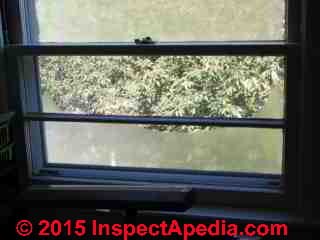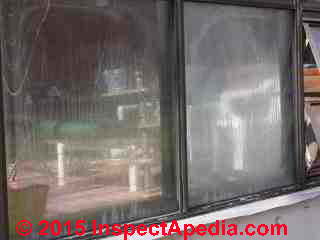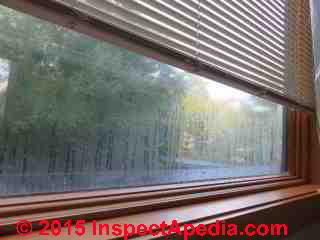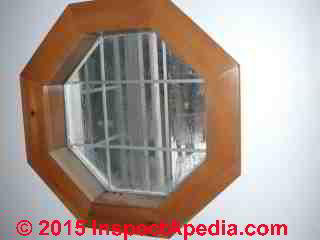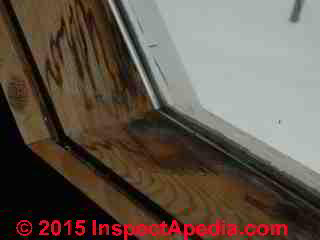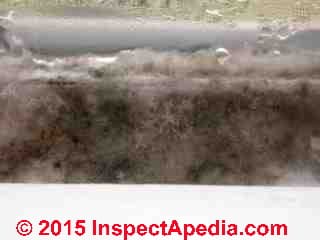 Window Condensation: Cause, Cure, Prevention, Resistance Ratings
Window Condensation: Cause, Cure, Prevention, Resistance Ratings
- POST a QUESTION or COMMENT about condensation on windows: troubleshooting, cure, prevention of window condensation & moisture
Window condensation problem troubleshooting & repair:
Window condensation is more than an aesthetic problem of foggy glass: condensation can cause costly damage to the window sash, window frame, and on occasion even to the surrounding structure.
This article discusses problems with excessive condensation on windows and skylights and reviews the causes and cures of window condensation, secondary effects (mold, rot, decay), and also the condensation resistance of window glazing materials.
Page top photo: high condensation is not the only moisture this window suffers: a conventional window located in a bath shower is exposed to water, leaks, and rot.
InspectAPedia tolerates no conflicts of interest. We have no relationship with advertisers, products, or services discussed at this website.
- Daniel Friedman, Publisher/Editor/Author - See WHO ARE WE?
Condensation Resistance Ratings for Windows: Window Condensation or "Sweating"
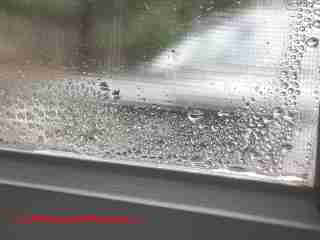
To rate a window’s resistance to condensation, NFRC recently developed a method that evaluates the window’s frame, glass, and glass edge at a standardized set of temperature and humidity conditions.
Based on the coldest part of the window assembly, it is assigned a rating from 1 to 100.
The higher the rating, the better the window is at resisting condensation, but the rating doesn’t predict condensation under specific conditions. The voluntary minimum for a “thermally improved window” under the AAMA/NWWDA standard is 35.
The best protection against condensation is low-E glass with gas fill, combined with warm-edge spacers and a nonmetallic window frame, such as wood, vinyl, fiberglass, or one of the newer composites.
Table 3-6 (below) provides a general guide to when condensation is likely to form on different types of glazing.
The table is provided by Steven Bliss, author of Best Practices Guide to Residential Construction (Steve Bliss, J Wiley & Sons) , courtesy of Wiley & Sons.
Without warm-edge spacers, condensation will occur at window edges first.
[Click to enlarge any image, photo, or table]
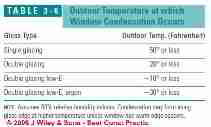
Types & Sources of Condensation Problems on Windows
In order to "fix" a problem with excessive condensation on windows or doors we need first to understand the cause of the problem.
Window Condensation Due to Interior Moisture
In the photograph below we see heavy condensation on the indoor side of an insulated-glass window installed on the Green Cabin, a home in northern Minnesota.
The Green Cabin was extensively renovated, is air tight and well insulated and sports tight insulated glass windows whose window seals are intact. At below right are the original windows of this 1920's cabin before renovations.
During cold weather with heat on in this environment, moisture produced by building occupants may combine with evaporation of melted snow stomped off of their shoes and boots at the Green Cabin's entry is sufficient to put enough moisture into the building's air that it condenses on window interior surfaces.
When the window moisture condensation problem observed in a structure occurs on all windows or on all windows on a particular side of the building (perhaps windows not receiving warmth from sunlight), we suspect that the problem is the combination of very cold outdoor temperatures with somewhat elevated indoor moisture.
The cures for simple high interior moisture condensation on building windows include:
- Reduce indoor relative humidity levels
- Increase indoor air movement across windows by opening drapes or even using a fan
- Add additional layers of window glazing as exterior storm windows
Window Condensation Due to Air Leaks Around Window Sashes
Taking a look at exactly which surface is carrying the condensation can often tell us the underlying cause of window fogging or moisture accumulation.
The photograph above illustrates condensation on the interior surface of the storm window of a New York home built in the 1960's.
I [DJF] think that when moisture appears on the inside of the storm window that probably means that the main or interior-most window sash is itself leaking so much warm moist air into the window cavity that the moisture is condensing on the colder surface of the exterior storm window.
Window Condensation Due to Point Moisture Sources
If you find window condensation occurring only on certain windows in a home, look for a relationship between local moisture or water sources and the window itself; the most common examples of window condensation due to a localized or "point" of moisture generation are windows in bathrooms and windows in kitchens.
Above we see a kitchen window with a generous coating of condensation on the interior surface of the principal window sash. Notice that window handle above the .com of our InspectApedia.com copyright notice?
That tells us that this is an awning type window being latched by that handle. Awning windows open out, hinged at the window top, making the installation of an exterior storm impossible except for storm windows affixed only to the movable window pane itself.
This homeowner installed an aluminum-framed sliding track storm window on the interior side of the original awning window. The interior storm is not air tight; moisture generated in the kitchen and kitchen warmth are sufficient to keep the interior storm too warm for condensation to appear on its surface.
But moisture driven through the leaky interior storm into the window cavity is condensing on the inner surface of the principal sash: the awning window.
We might see this type of window condensation also in rooms in homes in which a humidifier is being operated during dry winter weather.
Window Condensation Due to Lost Seal in Insulated Glass Windows or Doors: Cause & Cure
Below our photos show fogged glass at aluminum-framed sliding glass windows looking from outside (below left) and from inside at a different building (below right).
The problem here is not high indoor moisture levels but rather that the double pane "insulated" glass windows have lost their seal against air intrusion. Once an insulated glass window seal has been broken, changing temperatures and variations in barometric pressure are sufficient to periodically push outdoor or indoor air into the space between the insulated glass panes.
Several factors can cause the loss of seal of an insulated glass window including mechanical stresses such as uneven pressures on the window sash due to building or framing movement (perhaps due to inadequate framing around the window), poor quality original window sash construction, or mechanical damage to the window sash from other sources.
Because at least sometimes the air entering the insulated glass window sash (or door glass) contains more moisture than was in the desiccated air (or other gas) originally within the sealed window, that moisture first enters, then condenses on the interior surfaces of the glass.
Later even if changes in temperature and barometric pressure cause the window to "exhaust" or "breathe out" some of its air, the moisture that was condensed on the window glass interior surface remains.
The effect of the minute but ongoing breathing in and out of the insulated window whose seal has been lost is an accumulation of moisture and on occasions air and water borne minerals or dust. The combination of moisture, minerals and dust condensing on the interior surfaces of the insulated glass window causes an ever-increasing fogging of the window sash until it becomes as opaque as the windows shown in our photograph above.
The repair for this condition is window glass or complete window replacement.
Use of Blinds or Curtains Explain Window Condensation on Window Exterior
At above left we see heavy moisture condensation on the exterior of an insulated glass of the window on a well-insulated New York home. The moisture condensation that you see at above left is on the outside of the window glass. At above right is a second window in the same home, on the same side and with the same exposure, and taken at the same time as our first photograph, but with no condensation present. What's going on?
These photographs, taken early in the morning of a warm humid day in September 2015, illustrate the relationship between indoor temperature, indoor air movement across windows, outdoor temperature, high outdoor humidity, and condensation formation on the window's glass surface.
When these photographs were taken the room where these windows are located was at an indoor temperature that close to the outdoor temprature. Normally that would prevent condensation (of moisture in the air) from forming on the window surfaces.
But during the night before these photos were taken both outdoor temperatures and indoor temperatures fell, cooling the window glass.
Here, the closing of a venetian blind on the window at upper left made the difference. The window with outdoor condensation (above left) on its outdoor surface, had spent the night with venetian blinds "down" that is, covering the window, while the window without outdoor condensation (above right) had spent the night with no covering.
That's the only significant difference between these two windows. The venetian blinds on the with-condensation window provided just enough interference with indoor air movement against the window glass and just enough insulating value that in the early morning the temperature of the with-condensation glass remained cooler than the temperature of its neighboring without-condensation glass.
As outdoor temperatures rose and outdoor humidity also was soaring, the warm moist outdoor air was in contact with both windows.
Which window surface will see more condensation on its surface? The one that is cooler. As warm, moisture-laden outdoor air moved across the cooler window glass the air contacting the window surface cooled, giving up some of its moisture that in turn condensed on the glass surface.
If we leave the venetian blind up on the window at above left, in the morning it and its neighboring window (that has no venetian blind installed) will look the same. Use of curtains or venetian blinds can explain both outdoor condensation and indoor condensation on window surfaces.
Damage from Window Condensation
Damage from condensation forming on windows or storm windows ranges from cosmetic to structural in import.
The octagonal window shown above uses insulated glass but is in an area of both elevated indoor moisture and low air circulation.
Above you see stains on the wood around the bottom of this fixed glass octagonal window. Over a longer period there are added risks of mold growth, leaks into the wall cavity, window frame rot, and in extreme cases, rot in the wall framing around and below the window.
Mold growth encouraged by window condensate often forms on the window putty of older sashes or on the wood or plastic frames of newer window sashes.
Mold may also form on organic dust, debris, or paint on metal window sashes and frames. The total quantity in square feet of moldy area is virtually never going to be big enough to itself form a mold hazard requiring professional mold removal - we'd need to see more than 30 sq. ft. of contiguous mold to call for professional mold remediation.
See MOLD on PLASTIC WINDOWS
Really? An exception to the claim that mold on windows is itself unlikely to be a source of trouble for building occupants can arise when condensation on windows causes colonization of wood window frames by particularly irritating molds such as members of the Aspergillus sp. or Penicillium sp. families and where the moldy surfaces are in the air path between an open window and building occupants.
In the photo at above right we see a close-up of mold growth along the bottom of an awning type window that was immediately above the head of a bed. When occupants opened this window to admit fresh air during sleeping, cool night air flowed across this colony of Aspergillus sp. mold and fell another few feet onto the occupants, one of whom was both asthmatic and sensitive to airborne molds. The results included allergic response and asthma attacks until this little mold reservoir was observed and simply cleaned away.
See MOLD on WINDOWS, TRIM and also see
However condensate at windows that leaks into a wall cavity below could over time cause more substantial mold contamination by wetting wallpaper, drywall, or wall cavity insulation. Such damage may require a careful examination of the window indoors and from outside in order to distinguish between a window condensation problem and actual leaks around the window.
How to Avoid Condensation Problems on Skylight Windows
Because warm moist air is carried upward by convection currents, skylights are often one of the first places to develop condensation. This can lead to dripping and staining of the frame, well, or furnishings below.
The best defense against skylight condensation is to choose high R-value glazing with warm-edge spacers. Good insulation of the skylight well also helps by keeping the surrounding area warmer. Several manufacturers offer skylights with integral condensation gutters, a helpful feature in cold climates.
Condensation Resistance of Windows: Measurements
The NFRC (National Fenestration Council) in discussing solar heat gain at windows, describes the Condensation Resistance of Windows (CR) as follows:
Condensation Resistance (CR) measures how well a product resists the formation of condensation. CR is expressed as a number between 1 and 100. The higher the number, the better a product is able to resist condensation. CR is an optional rating, and manufacturers can choose not to include it on their NFRC labels. - NFRC atReferences or Citations
Window Information Sources
- In our WINDOWS & DOORS article series we discuss the selection and installation of windows and doors, following best construction and design practices for building lighting and ventilation, with attention to the impact on building heating and cooling costs, indoor air quality, and comfort of occupants. We review the proper installation details for windows and doors, and we compare the durability of different window and door materials and types. This article includes excerpts or adaptations from Best Practices Guide to Residential Construction (Steve Bliss, J Wiley & Sons) , by Steven Bliss, courtesy of Wiley & Sons.
- American Architectural Manufacturers Association (AAMA) www.aamanet.org
- Efficient Windows Collaborative www.efficientwindows.org
- National Fenestration Rating Council (NFRC) www.nfrc.org Sustainable by Design www.susdesign.com
- Shareware calculators for sun angles, solar heat gain, and shading
- Window and Door Manufacturers Association (WDMA) www.wdma.com
- - Portions of this article were adapted and paraphrased, edited, and supplemented, with permission from Best Practices Guide to Residential Construction (Steve Bliss, J Wiley & Sons) .
...
Reader Comments, Questions & Answers About The Article Above
Below you will find questions and answers previously posted on this page at its page bottom reader comment box.
Reader Q&A - also see RECOMMENDED ARTICLES & FAQs
Question:
(Dec 16, 2012) Leslie Tucker said:
Bought a great modular home in Colorado this October, but noticed streaks ans tiny debri on tubular skylight after first snowfall this season. What does this suggest and how can this be prevented? How is it to be cleaned from the inside of the house?
Reply:
Check for missing insulation or leaks or air bypass leaks around the skylight sides; Also of course watch for roof leaks.
...
Continue reading at DEW POINT TABLE - CONDENSATION POINT GUIDE or select a topic from the closely-related articles below, or see the complete ARTICLE INDEX.
Or see
CONDENSATION or SWEATING PIPES, TANKS
MOISTURE PROBLEMS: CAUSE & CURE - home
SKYLIGHT LEAK DIAGNOSIS & REPAIR
WINDOWS & DOORS - home
Suggested citation for this web page
CONDENSATION on WINDOWS, SKYLIGHTS at InspectApedia.com - online encyclopedia of building & environmental inspection, testing, diagnosis, repair, & problem prevention advice.
Or see this
INDEX to RELATED ARTICLES: ARTICLE INDEX to DOORS & WINDOWS
Or use the SEARCH BOX found below to Ask a Question or Search InspectApedia
Ask a Question or Search InspectApedia
Try the search box just below, or if you prefer, post a question or comment in the Comments box below and we will respond promptly.
Search the InspectApedia website
Note: appearance of your Comment below may be delayed: if your comment contains an image, photograph, web link, or text that looks to the software as if it might be a web link, your posting will appear after it has been approved by a moderator. Apologies for the delay.
Only one image can be added per comment but you can post as many comments, and therefore images, as you like.
You will not receive a notification when a response to your question has been posted.
Please bookmark this page to make it easy for you to check back for our response.
IF above you see "Comment Form is loading comments..." then COMMENT BOX - countable.ca / bawkbox.com IS NOT WORKING.
In any case you are welcome to send an email directly to us at InspectApedia.com at editor@inspectApedia.com
We'll reply to you directly. Please help us help you by noting, in your email, the URL of the InspectApedia page where you wanted to comment.
Citations & References
In addition to any citations in the article above, a full list is available on request.
- Basic Housing Inspection, US DHEW, S 352.75 U48, p.144, out of print, but is available in most state libraries; New York State version, ca 1955, source of our window parts and window repair sketches.
- Best Practices Guide to Residential Construction, by Steven Bliss. John Wiley & Sons, 2006. ISBN-10: 0471648361, ISBN-13: 978-0471648369, Hardcover: 320 pages, available from Amazon.com and also Wiley.com. See our book review of this publication.
- "Solar Heat Gain & Windows, the facts about", NFRC, National Fenestration Rating Council, January 2005, NFRC website: www.nfrc.org retrieved 12/4/2010, original source: http://www.nfrc.org/documents/SolarHeatGain.pdf.
- Our recommended books about building & mechanical systems design, inspection, problem diagnosis, and repair, and about indoor environment and IAQ testing, diagnosis, and cleanup are at the InspectAPedia Bookstore. Also see our Book Reviews - InspectAPedia.
- Decks and Porches, the JLC Guide to, Best Practices for Outdoor Spaces, Steve Bliss (Editor), The Journal of Light Construction, Williston VT, 2010 ISBN 10: 1-928580-42-4, ISBN 13: 978-1-928580-42-3, available from Amazon.com
- The Journal of Light Construction has generously given reprint permission to InspectAPedia.com for adaptations, quotations, or reproductions used at this website. All rights and contents of the JLC material are ©Journal of Light Construction and may not be reproduced in any form.
- In addition to citations & references found in this article, see the research citations given at the end of the related articles found at our suggested
CONTINUE READING or RECOMMENDED ARTICLES.
- Carson, Dunlop & Associates Ltd., 120 Carlton Street Suite 407, Toronto ON M5A 4K2. Tel: (416) 964-9415 1-800-268-7070 Email: info@carsondunlop.com. Alan Carson is a past president of ASHI, the American Society of Home Inspectors.
Thanks to Alan Carson and Bob Dunlop, for permission for InspectAPedia to use text excerpts from The HOME REFERENCE BOOK - the Encyclopedia of Homes and to use illustrations from The ILLUSTRATED HOME .
Carson Dunlop Associates provides extensive home inspection education and report writing material. In gratitude we provide links to tsome Carson Dunlop Associates products and services.




